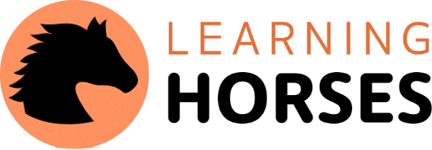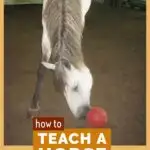Training a horse to fetch a ball, a hat, or any object on command is possible- it just takes practice and patience!
In this article, I’ll walk you through the steps I use to trick train horses to retrieve objects on command. Teaching a horse to pick up an object and bring it to you is a great “party trick,” and once your horse has learned the trick well, you can even use the same training to teach your horse to pick up dropped items with its teeth and pass them to you while you are mounted.

With frequent, short sessions you can have your horse picking up and retrieving items in a matter of days. It’s the perfect activity for bonding with your horse when it’s too cold to ride, or keeping them from going stir crazy while on veterinarian-ordered stall rest. In this article, we’ll use a clicker & horse treats as the behavior reinforcement method.
Clicker training is an evidence-based training method that uses positive reinforcement to quickly train horses for tricks or useful behaviors like laying down on command or standing square for conformation judging. You can have success training with reward alone, but the clicker will speed up training significantly by allowing you to “mark” the exact behavior you are rewarding.
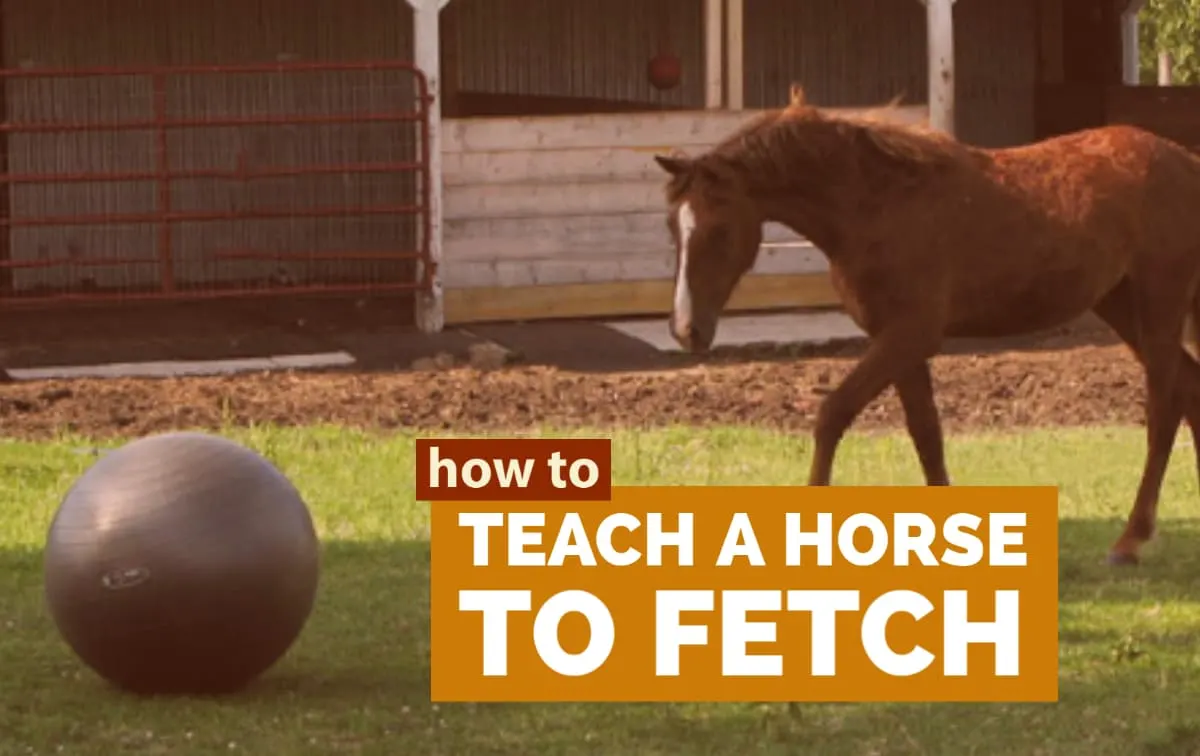
Teaching dogs to fetch is easy. Simply throw a ball, and, often as not, they’ll return it right back to your hand. With horses (who lack this particular instinct) we turn it around a little: Instead of beginning at the beginning- the act of fetching or picking up an item, we’ll begin at the end- putting the object in your hands.
If your long-term goal is teaching your horse to pick up or fetch something, begin by teaching them to “give” something. Once the horse understands the reward is earned by giving you the object, they’ll train themselves to retrieve any object in order to give it to you.
Step By Step Instructions for Teaching a Horse to Fetch:
The following section may contain affiliate links. As an Amazon Associate, we earn from qualifying purchases.
Begin by standing with your horse and your chosen “fetch” object- I start teaching this trick with a dog-sized Jolly Ball (I prefer the smaller size as it is easy to hold in one hand and light weight). Whatever object you choose, be sure to store it between training sessions. This helps keep the object interesting and attention-catching for your horse.
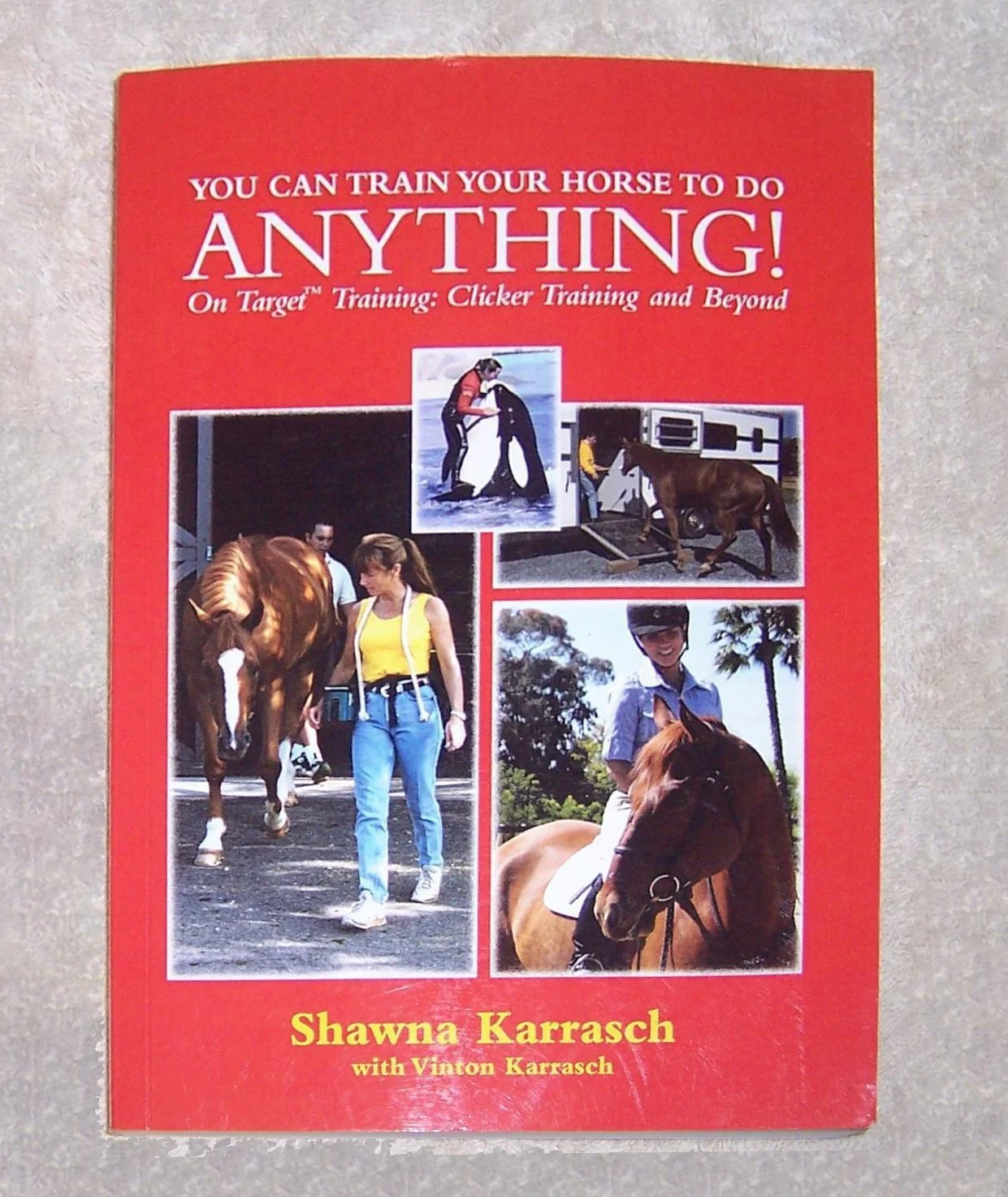
To train, we’ll first break the trick into several smaller tricks:
Horse Fetch Training Goal #1: lipping and mouthing the most accessible surface of your object.
In the case of the jolly ball, when the horse shows interest and lips at the handle, click and offer a treat. After the horse is comfortable lipping, offer the object in the same way but withhold the click and reward until horse opens their mouth and bites down on the handle.
Horse Fetch Training Goal # 2: Holding the Object.
When the horse is biting down comfortably on the object in your hand, begin waiting for longer periods of biting before you praise. Try removing your supportive hand so they bear the weight of the ball. Click and reward if they hold the object. Praise strongly if the horse tries lifting or snatching object on their own, but do not reward if they drop the ball anywhere other than back into your hands.
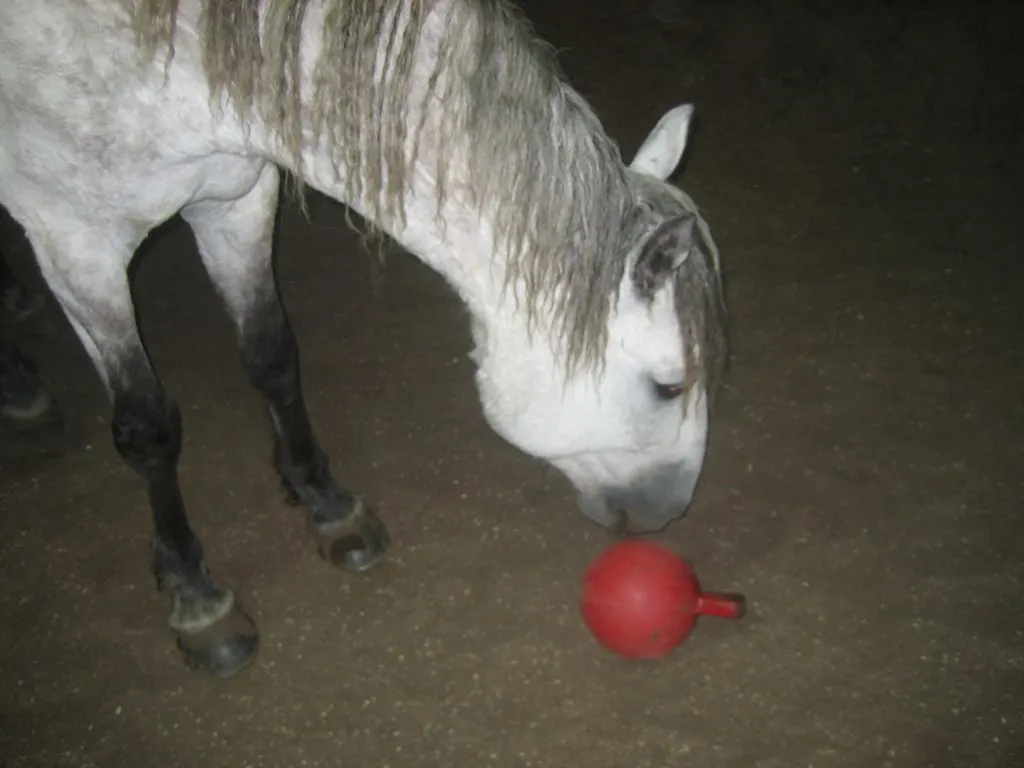
Goal 3. Dropping Object in your Hands.
When the horse is confidently biting down and holding the weight the of object in their mouth, start withholding praise until the horse drops the object back into your hands. At this point, the horse should be chaining behaviors and understanding the action for which they earn a treat is “bite, hold, drop into hands.” Remember to keep training sessions short! 5-7 minutes is an ideal training session length when trick training a horse.
Goal 4. Solidifying Earlier Steps + Complications.
After the last step is solid, begin manipulating the object and holding it in different places. If you were holding the object/ball at chest height for the horse to snatch, begin offering a different side of the ball, or holding the object above your head or by your knee. Always withhold praise until the horse has taken the object, held, and dropped into your hands back in the normal position. If they drop the jolly ball during the trick, just quietly pick up and hold, inviting the horse to start again.
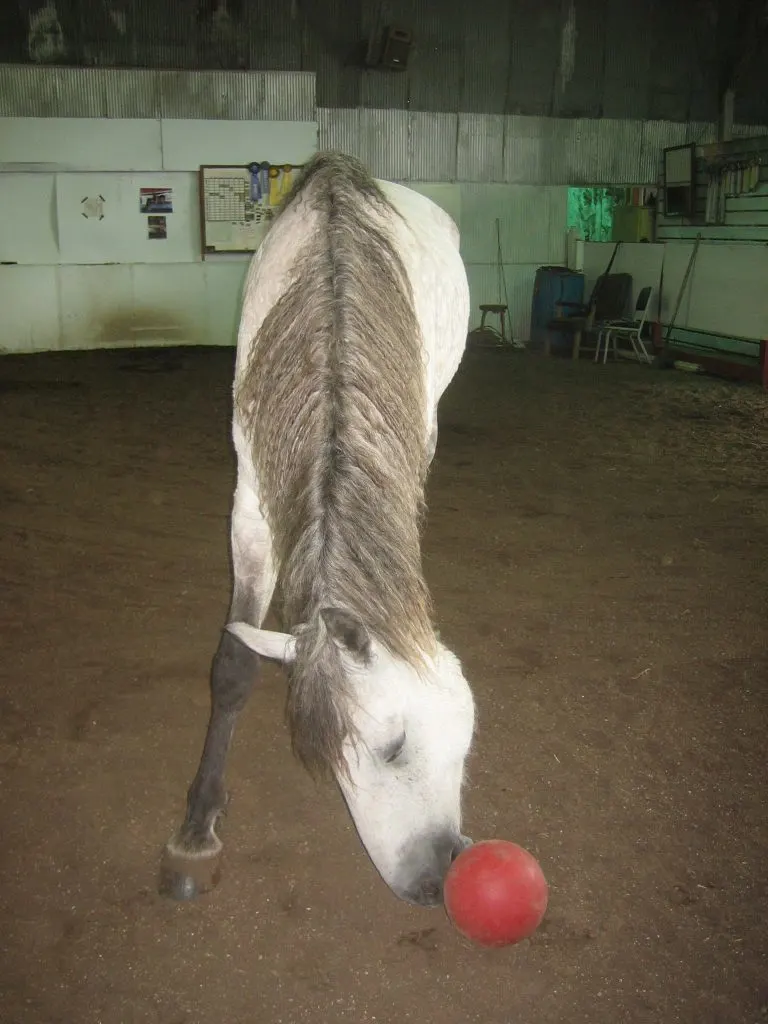
Goal 5. Place Object Farther away and Add Retrieving.
Gradually move the object farther and farther from yourself. At first, this may mean setting the object next to your shoe, then 1 foot to the left, then 3 feet to the left, etc. Eventually, you should be able to increase the distance until you are able to toss the object and the horse returns it to your hands.
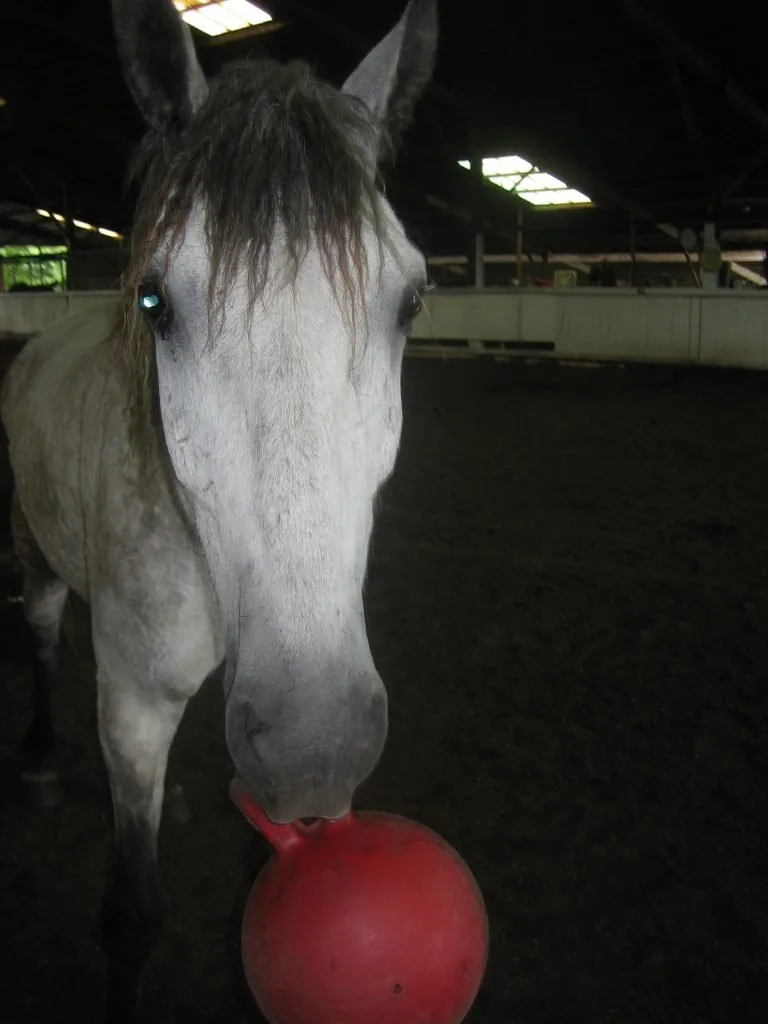
Remember that teaching a horse to pick up a hat or any object is a complex trick that needs to be taught over many sessions, but it’s a basic chain of easily-trained behaviors. With patience (and a small investment in a clicker) any horse can be taught to fetch, or to learn the classic rodeo trick of returning a dropped cowboy hat.
Remember: Trick training for horses is challenging for both horses and handlers new to the activity. Like training a feline to do one of the many tricks to teach your cat, horses lose interest in this sort of training quickly. Your best horse trick-training results will be achieved through daily or 2x daily short sessions. For best results, try to work on your horse’s fetching skills 5 minutes 5 days a week rather than 30 minutes once a week.
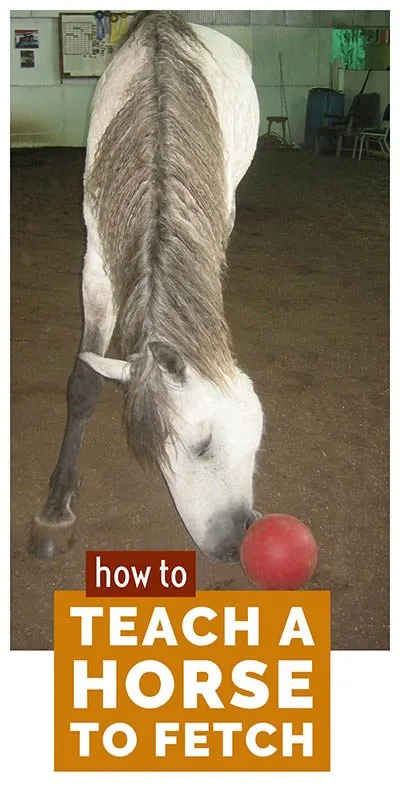
Fetch Foundation: Three Advanced Horse Tricks
Trick training horses doesn’t just end at the basics; your imagination is the limit! With the groundwork of teaching your horse to fetch in place, there are many advanced fun tricks awaiting.
Here are three spin-off tricks to spice up your horse trick training sessions:
1. Bucket Drop:
In this trick, you’ll train your horse to return the ball by dropping it into a bucket. This variation is great for horses that spend time with kids or therapy horses- the bucket drop removes the potential for a person to be bumped when the horse returns the object.
Start with the object your horse is familiar with fetching (I usually begin with a Jolly Ball). Place a sturdy bucket a short distance away. Hold out the object, and once your horse picks it up, guide it over the bucket and use the “drop” command.
Training Steps:
- Begin by handing the ball to your horse directly over the bucket and cueing the horse to drop it in.
- Once comfortable, increase the challenge. Gradually move farther away, having your horse approach the bucket to drop the fetched item.
- Remember to reward each successful drop! Over time, you’ll have your horse confidently fetching the ball and dunking it into a bucket with confidence.
2. Retrieving Specific Objects:
Horses are intelligent creatures, and they can distinguish between different objects.
Once your horse knows how to fetch a tossed object, you can teach them to do a simple retrieval of specific items based on their shape or size.
Training Steps:
- Introduce a new shape, like a soft frisbee or a hard plastic dog toy. Using the same “fetch” command, assign the object a name, and encourage your horse to pick it up.
- Next, lay out multiple objects. Guide your horse to the one you want, using the assigned name, reinforcing the fetch command and the name over many short training sessions.
- As your horse gets better, command fetch and point to the desired object. Celebrate each correct fetch with a click and treat.
- Soon, you can begin teaching your horse to grasp and deliver useful and entertaining objects- like grooming brushes, backpacks, etc!
3. Introducing Obstacles:
Building a horse jump and integrating it is an athletic twist. Using the fetch foundation, we’ll introduce a jump for the horse to jump over before fetching its favorite object.
Training Steps:
- Start by setting up the jump. Make sure that it’s not too high for your horse to comfortably jump over without too much effort.
- Lay the fetch object just beyond the jump, encouraging your horse to walk over the jump to retrieve it.
- Always prioritize safety! Ensure the jump is stable and at a safe height that’s not too challenging.
- With consistency and encouragement, your horse will have a showcase trick that combines agility with the fetch trick.
With each of these advanced tricks, remember the golden rules of hors trick training: keep training sessions short, rely on positive reinforcement, and always prioritize safety.
Trick-training horses can not only deepen your bond with your horse but also continually challenge and stimulate its intellect, which can lead to fewer boredom-related behaviors like cribbing and other stable vices. Happy trick training!
